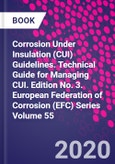Corrosion Under Insulation (CUI) Guidelines: Technical Guide for Managing CUI, Third Edition, Volume 55 builds upon the success of the first two editions to provide a fully up-to-date, practical source of information on how to monitor and manage insulated systems. In the first edition of this book published in 2008, the EFC Working Parties WP13 and WP15 engaged together to provide guidelines on managing CUI with contributions from a number of European refining, petrochemical, and offshore companies. The guidelines were intended for use on all plants and installations that contain insulated vessels, piping, and equipment, and cover a risk-based inspection methodology for CUI, inspection techniques, and recommended best practices for mitigating CUI.
The guidelines include design of plant and equipment, coatings and the use of thermal spray techniques, types of insulation, cladding/jacketing materials, and protection guards. Corrosion-under-insulation (CUI) refers to the external corrosion of piping and vessels that occurs underneath externally clad/jacketed insulation as a result of the penetration of water. By its very nature CUI tends to remain undetected until the insulation and cladding/jacketing is removed to allow inspection, or when leaks occur. CUI is a common problem shared by the refining, petrochemical, power, industrial, onshore and offshore industries.
Please Note: This is an On Demand product, delivery may take up to 11 working days after payment has been received.
Table of Contents
1. Introduction 2. Economic consideration 3. Ownership and responsibility 4. The risk-based inspection methodology for corrosion-under-insulation 5. Inspection activities and strategy 6. Non-destructive examination and testing screening techniques for corrosion-under-insulation 7. Recommended best practice to mitigate corrosion-under-insulation 8. Design for the prevention of corrosion-under-insulation
Appendix A. Cost-economic evaluation B. Quality assurance C. Additional guidelines on the implementation of corrosion-under-insulation best practice D. Coatings E. Application of thermally sprayed aluminium F. Insulation material types and forms G. Cladding and jacketing materials H. Use of protection guards I. Non-destructive examination and testing techniques








